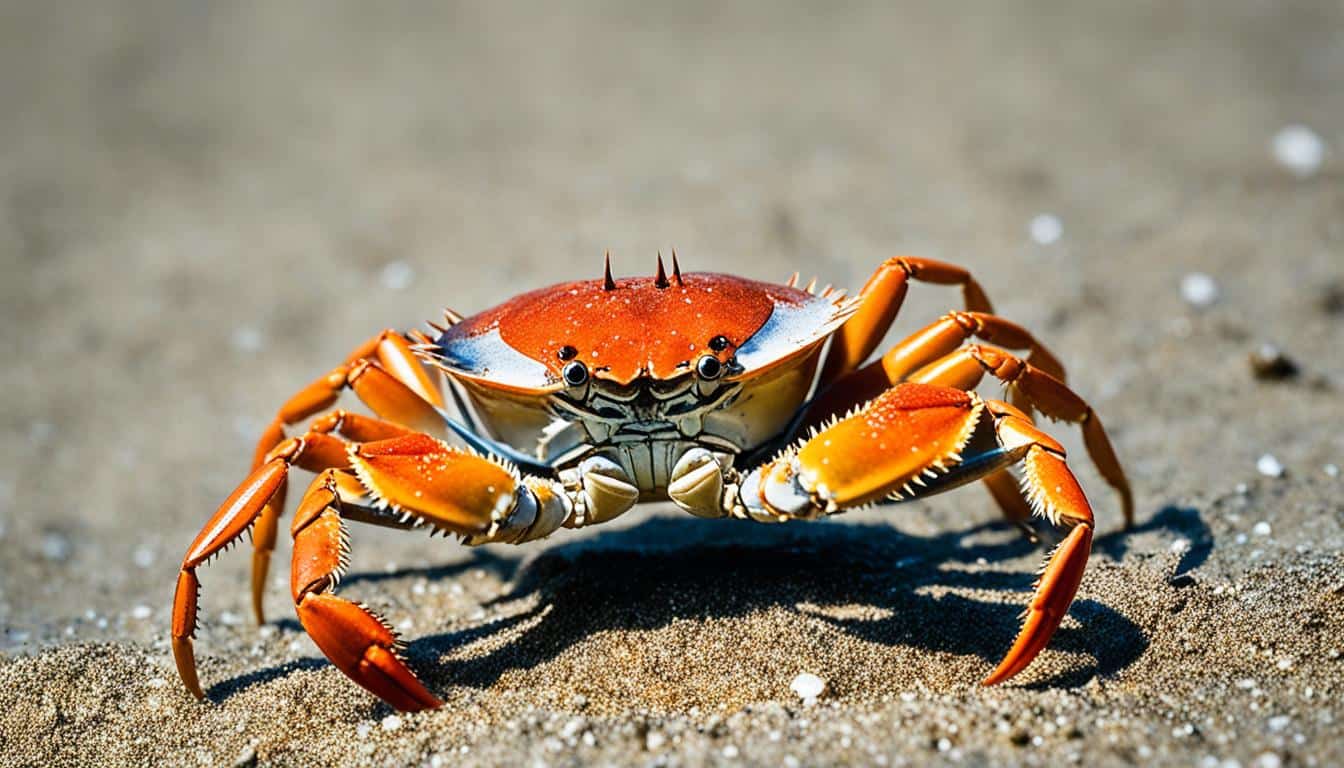Crabs are amazing creatures with unique ways to survive. Learning about their defense methods shows us their fascinating behaviors. It also highlights the crucial role they play in keeping nature in balance. With more than 7,000 types, crabs use many ways to protect themselves from predators. This article will explore the detailed self-defense tactics of these tough animals, helping them survive in different places.
Understanding Crab Defense Mechanisms
Crabs have many ways to protect themselves from predators. They use their biology and behavior to stay safe. For example, they have a hard shell that acts as a shield. Some crabs also change color to warn off predators or hide from them.
Overview of Common Defense Strategies
Crabs use different ways to protect themselves, depending on where they live. Some main strategies include:
- Hard Exoskeleton: This is their main defense against predators.
- Camouflage: Many crabs change color or look like their surroundings to hide.
- Behavioral Tactics: They move fast and hide to stay safe when danger comes.
Importance of Adaptation in Different Species
Adaptation is key for crabs to survive in different places. They have special traits that help them defend themselves. For example, sponge crabs use sponges to cover themselves, while decorator crabs add algae and other stuff to their look.
These special traits help crabs avoid predators and do well in changing environments. They also help them have more babies and survive better.
How do crabs defend themselves?
Crabs have many ways to protect themselves, using their unique biology and behaviors. These methods help them survive in the wild and show how well they adapt to different places.
Use of Exoskeletons for Protection
The main way crabs defend themselves is with their exoskeleton, a hard shell made of chitin. This shell acts as a strong barrier against predators. It protects the crab’s soft body, making it hard for predators to hurt them.
When crabs shed their exoskeleton to grow, they become more vulnerable. They need to find a safe place until their new shell hardens. This is why they hide during this time.
Behavioral Tactics: Hiding and Camouflaging
Crabs also use behavior to defend themselves, like hiding or blending in. Many species are more active at night or during low tide to avoid predators. They hide under rocks or in plants, making it hard to see them.
This way of hiding helps their physical defenses. It shows how they use both body and mind to survive.
Regenerative Capabilities of Crabs
Crabs can also regrow lost limbs, which is another defense strategy. If caught by a predator, they can lose a claw or leg to distract the attacker. This lets them escape while the predator is confused.
Crabs can regrow their lost limbs over time. This ability helps them recover and keep thriving despite the dangers they face.
| Defense Mechanism | Description | Examples |
|---|---|---|
| Exoskeleton | Hard outer shell providing protection from predators. | Chitin-based exoskeleton in various crab species. |
| Camouflage | Blending into the surroundings to avoid detection. | Crabs hiding under rocks or in seagrass. |
| Regeneration | Ability to regrow lost limbs after injury. | Shedding a claw to distract predators. |
Crab Camouflage Techniques
Crabs have amazing ways to hide from predators. Decorator crabs and sponge crabs are great examples. They use special ways to blend in and stay safe.
Decorator Crabs and Their Unique Adaptations
Decorator crabs are known for their clever hiding skills. They stick seaweed, sponges, and corals to their shells. This helps them blend in and keeps predators away. Some of these materials can even be toxic, adding an extra layer of protection.
Sponge Crabs: The Masters of Disguise
Sponge crabs are experts at hiding. They cover themselves with sponges, making them look just like a sponge. This not only helps them hide but can also protect them from predators by using the sponge’s toxins. Sponge crabs show how complex crab camouflage can be.

Crab Shell Protection
Crabs have a hard exoskeleton that is key to their survival. This tough shell protects them from predators and helps them move and eat. It’s important for crab survival and helps them avoid predators.
How Hard Exoskeletons Offer Safety
A crab’s exoskeleton is crucial for defense. It can take a lot of force from predators, keeping you safe. Made of chitin, it’s both strong and light, making it perfect for moving and staying safe.
Vulnerability During Molting Stages
But, crabs are more vulnerable during molting. When they shed their shell for a new one, they’re soft and unprotected. Finding a safe spot is key to avoiding predators during this time. This shows how important it is to balance safety and growth in a crab’s life.
FAQ
What are the primary defense mechanisms crabs use to protect themselves from predators?
Crabs use many ways to stay safe, like their strong shell, hiding, and blending in. They can also regrow lost parts to avoid predators.
How does a crab’s exoskeleton provide protection?
The crab’s exoskeleton is made of chitin and acts as a hard shell. It protects the crab’s soft body from harm. It also helps with movement and eating.
What role does adaptation play in crab defense strategies?
Adaptation is key for survival. Crabs adapt to their homes with unique ways to avoid predators. This helps them survive in different places.
Can crabs camouflage themselves? How?
Yes, crabs can hide by attaching algae or other stuff to their bodies. They use sponges and other things to blend in, making it hard to spot them.
What are the challenges crabs face during the molting process?
When molting, crabs are very vulnerable. They shed their old shell and wait for a new one to harden. They hide to avoid being eaten during this time.
How do decorator crabs maintain their disguise?
Decorator crabs use things from their environment to look like their surroundings. This helps them hide and might also make them less tasty to predators.
What are the regenerative capabilities of crabs?
Crabs can regrow lost claws or legs. If they lose a part to get away from a predator, they use the distraction to escape safely.
How does the hardness of a crab’s exoskeleton contribute to its survival?
The strong exoskeleton helps crabs fight off predators. It’s a crucial defense that helps them live in their habitats.







